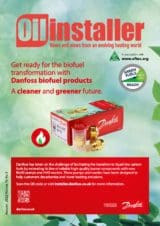It is essential that OFTEC registered technicians become familiar with these new requirements, many of which will require new ways of designing and installing appliances and heating systems. ADL comes into force 23rd November 2022 and any work started from that date will need to comply with its enhanced requirements.
Thankfully the Welsh Government has mirrored the requirements now in force in England, so installers who work across the border can work to the same standards.
What are the significant changes you need to know about? One way to find out is to view the webinar hosted by OFTEC covering changes to ADL in England. This can be found by scanning the QR code below:

Here is an overview of significant changes:
The end of compliance guides
Previously, most guidance for installers was found in the Domestic Building Services Compliance Guide. From November, this document no longer exists for use in Wales. All guidance is now contained in ADL.
Low temperature heating
Newly installed heating systems and completely replaced heating systems (including the heating appliance, heat emitters and pipework) should be designed to be able to run at a maximum flow temp of 550C. This is designed to ensure heating systems installed from November onwards are suitable for heat pumps later. This might require some upskilling for heating engineers, as pipe and radiator sizing will need to be carefully specified to ensure enough heat
is provided to each room. It is strongly recommended that you dig out your copy of the Domestic Heating Design Guide to remind yourself on how to do this. OFTEC has created a calculator to aid radiator selection.
Specification of services
ADL states that heating systems should be based on building-specific heat loss calculations, and hot water storage should be based on anticipated demand. Neither should be significantly oversized. On this basis, installers will need to ensure they keep records of such calculations to demonstrate compliance.
Enhanced minimum efficiencies
In exceptional circumstances, where the criteria of the ‘Guide to condensing boiler installation assessment procedure for dwellings’ is met, minimum efficiencies are 84% (SEDBUK 2009) for a regular boiler or 82% for a combi- boiler.
Appliance replacements
For some time, it has been a requirement that before replacing a domestic primary heating appliance with an appliance that runs on a different fuel, you should compare the carbon emissions of the new appliance to that of the existing appliance and then consider whether the appliance replacement is permissible. This process has been strengthened. A second calculation has been added to verify that the replacement appliance will not have a higher primary energy demand. This means that all the following must be true for a compliant appliance replacement:
- The appliance should be at least as efficient as the minimum seasonal efficiency required for that fuel.
- The replacement appliance should not or produce more carbon emissions.
- The replacement appliance should not have a higher primary energy demand.
Heat pumps are exempt from this calculation if they meet the minimum efficiencies in the tables above. ADL explains how to compare emissions and primary energy using fuel factors and a mathematical calculation. However, to assist technicians, OFTEC has updated the handy fuel-switching calculation tool hosted in the registered technicians section of www.oftec.org.
Where replacing an appliance with one using the same fuel, the new appliance must be at least as efficient as the minimum efficiencies in the tables above and at least as efficient as the appliance being replaced.
Solid fuel appliances
Guidance on the installation of appliance types B1,B2,B3 (open fires), C1,C2 (open fire and non-high output boiler), and J3,J4 (multifuel or anthracite boilers) are no longer listed as suitable to install. This represents any appliance that can burn mineral fuels. OFTEC is seeking clarification about whether this means such appliances cannot be installed or whether this is designed to steer installers away from such products.
Heat pumps
Heat pumps should be selected to meet the full space heating requirement at the design condition chosen for heat loss calculations. Where there are other heat sources available in a building with a heat pump, each of these heat sources should be appropriately incorporated into a singular control system.
Heat pumps should not be sited adjacent to sleeping areas or on materials that can readily transmit vibrations. Additionally, the location of external fans and heat pump compressors should be appropriately selected to minimise disturbance to neighbours, while remaining in compliance with planning requirements.
Commissioning information for the ground arrays of a ground source heat pumps has been updated.
Controls
Where a heating system is installed, or a boiler replaced, in nearly every case each room should be provided with thermostatic room controls. This can be achieved by one of the following:
- A thermostat in a room that the heating circuit serves and an individual thermostatic room control for each heat emitter, such as a thermostatic radiator valve, on all heat emitters outside the room that contains the thermostat. Thermostatic radiator valves should not be used in the same room as the thermostat.
- An individual room/heating zone thermostat or fan coil thermostat for each room or heating zone.
- An individual networked heat emitter control for each emitter.
Secondary DHW circuits should be timed separately from space heating. Where working on an existing system, if domestic hot water and space heating are controlled by a single time controller, then these may continue to be controlled together after the work is complete.
Finally
Hopefully this article has given you a flavour of the changes coming on 23rd November 2022. It is strongly recommended you download the new Approved Document and use it as a guide to assist you with quoting for work that will commence after this date. ADL is available from the Welsh Government website or can be accessed via the QR code below:

At the time of print, the Welsh Government had yet to release the non-domestic volume of ADL. OFTEC’s hard working technical department will review new guidance once it is published and will issue helpful tools and Technical Notices to ensure technicians working at any building are well informed and compliant.
